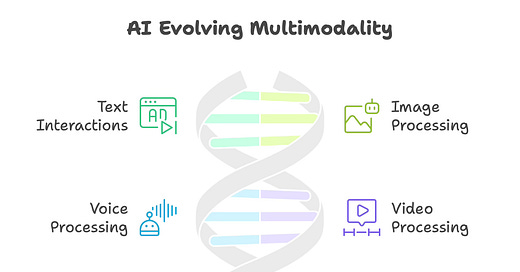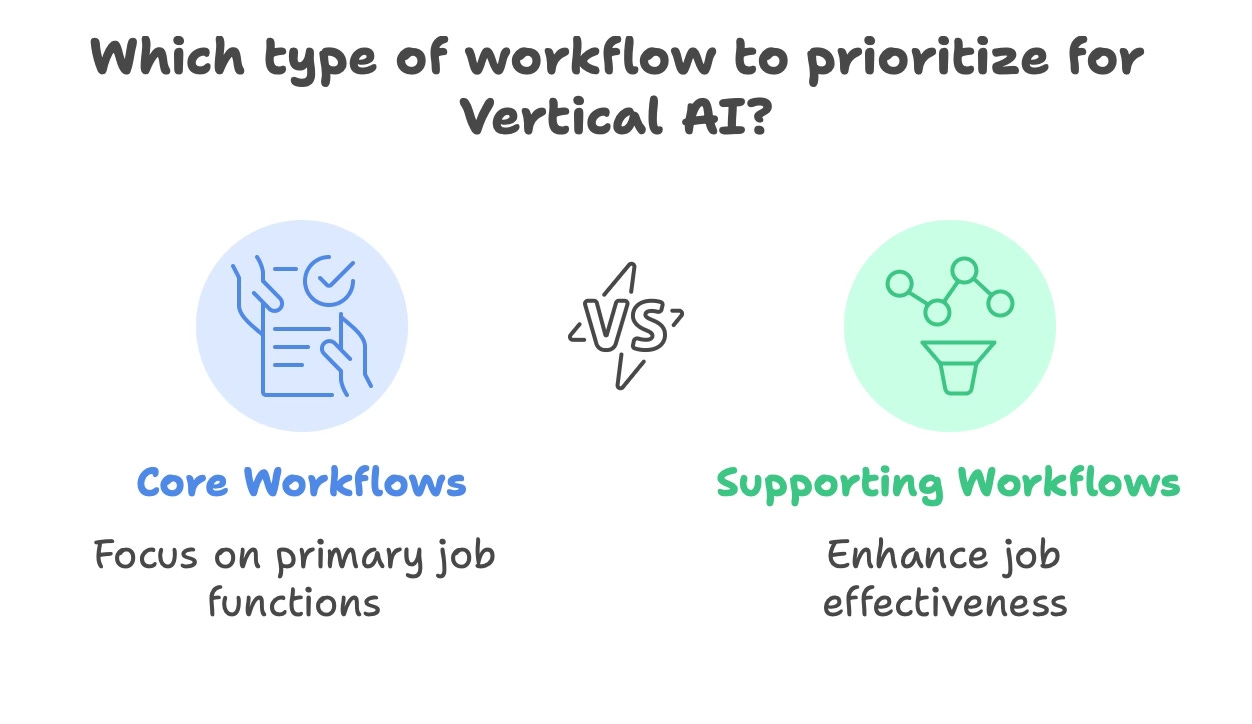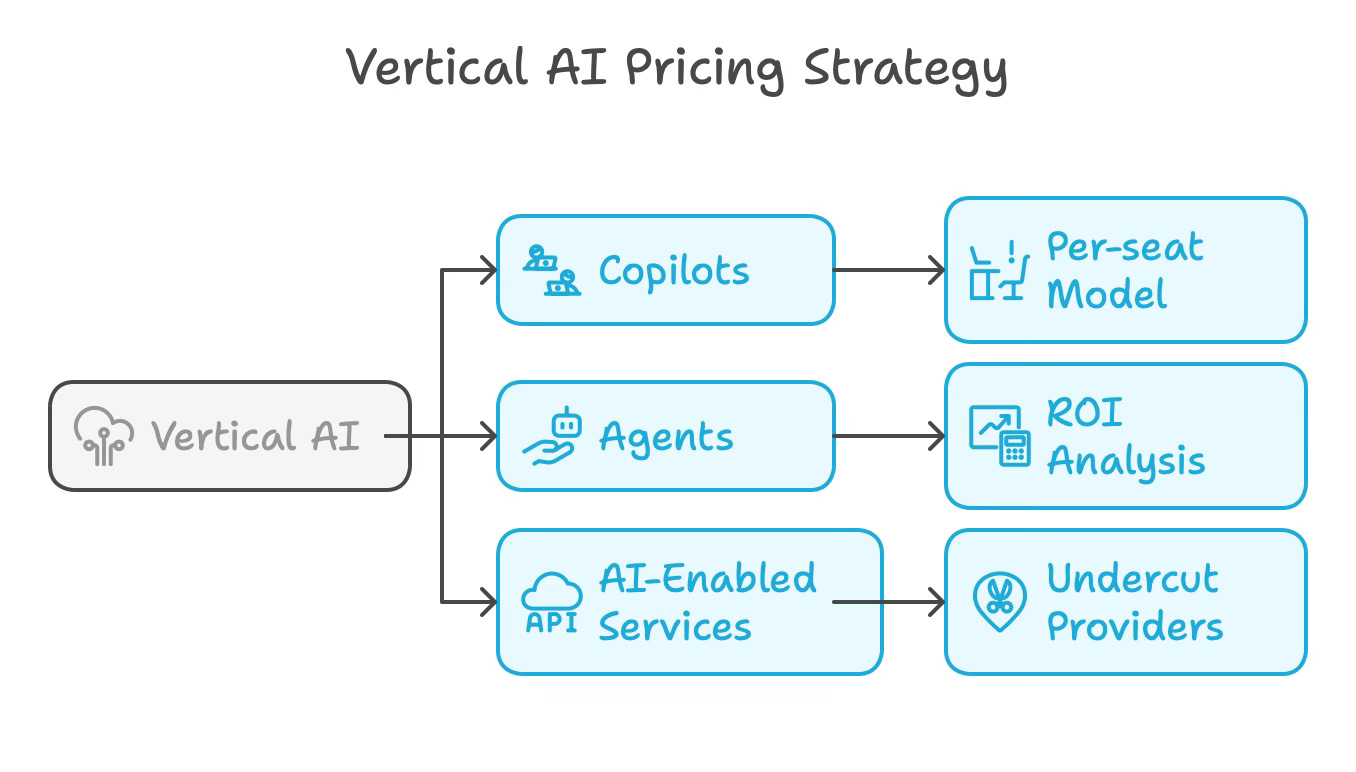Bessemer Venture Partners has built one of the largest vertical SaaS portfolio in venture and has developed insight and best practices from over a decade of funding industry defining companies.
The rise of Vertical AI represents a transformative moment in enterprise software. By leveraging large language models (LLMs) and generative AI, startups and established companies alike are creating tailored solutions to address industry-specific challenges. Bessemer Venture Partners' Vertical AI Roadmap provides a comprehensive guide to this burgeoning field, exploring its opportunities, innovations, business models, and strategies for defensibility. Below is a breakdown of the roadmap's key insights.
Part I - The Opportunity and Dynamics of Vertical AI
Read part I for the full publication.
Vertical AI is reshaping industries by addressing high-cost, repetitive language-based tasks that traditional vertical SaaS could not tackle. This new class of applications is unlocking massive value across sectors like healthcare, legal, and finance, which represent a total addressable market (TAM) ten times larger than traditional software markets. This market sizing is extrapolated from looking at the opportunity for software to take a growing share of expenditures typically allocated to labor and repetitive tasks
Key Opportunities:
Expanding TAMs: Vertical AI enables businesses to access previously untapped markets by delivering significant value through automation. For example, EvenUp automates demand letter generation for personal injury attorneys, allowing firms to increase margins and serve more clients.
Unlocking New Functions: Unlike legacy software, Vertical AI can penetrate industries with historically low technology adoption, such as healthcare and law. A solution like Abridge in healthcare turns patient-doctor conversations into clinical notes. In legal, AI co-pilot solutions automate critical workflows for contracting, case intake and other time-intensive tasks.
Delivering Unprecedented Value: By automating tasks that were previously impossible or too expensive for human labor, Vertical AI is creating transformative efficiencies. For instance, JusticeText reviews hours of video evidence for public defenders, drastically reducing a manual and time-intensive effort.
Core vs. Supporting Workflows:
Winners in Vertical SaaS developed vertically integrated platforms offering an all-in-one solution for a given vertical: Procore for construction, Toast for restaurants.
Vertical AI businesses can access larger TAMs within a given market by focusing on high-ROI solutions and staying more focused on specific workflows: core or supporting.
Core workflows are workflows that are a primary function of a job (e.g., contract drafting for lawyers). Fieldguide is a good example of Vertical AI revolutionizing the core workflows for auditors involved in diverse projects such as SOC 2 engagements, financial audits, PCI DSS assessments, and internal audits. By leveraging automation and generative AI, Fieldguide enhances auditor efficiency, leading to significant productivity gains in tasks where professionals spend most of their time.
Supporting workflows are workflows that are incidental to a job or business but still necessary (e.g., marketing and patient relationship management for a dentist). Vertical AI startups focused on supporting workflows will need to deliver meaningfully better solutions than incumbent vertical SaaS vendors likely to incorporate such AI into their platforms.
Both approaches offer unique opportunities but require careful alignment with customer needs and regulatory landscape.
Part II - Multimodal Innovation and Its Impact on AI Applications
Read part II for the full publication.
The emergence of multimodal models—capable of processing text, images, voice, and video—has expanded the scope of Vertical AI applications significantly. These advancements are enabling businesses to address complex tasks across various data types.
New modes of interaction are creating new opportunities:
Voice Capabilities:
Speech-to-Speech Models: New technologies like OpenAI's Realtime API allow for low-latency, context-rich conversational voice applications. These models capture user sentiment and emotion, enhancing natural interactions.
Use Cases: Applications range from medical transcription (e.g., Abridge) to automated customer support and outbound sales calls.
Vision Capabilities:
Image and Video Understanding: Models like GPT-4V and Gemini 1.5 Pro are enabling use cases such as data extraction from unstructured documents, quality assurance in construction, and video analytics for safety monitoring.
Design Automation: Applications range from data extraction for invoice automation to jobs involving visual inspection (e.g., xBuild for insurance inspection and estimates) to 2D and 3D designs (e.g., Snaptrude streamlines 3D design processes in architecture and engineering) and video analytics (e.g. video feed monitoring).
Across all vision use cases, the value to customers will almost always be directly tied to how well the automation fits within a user's existing workflow.
The Promise of AI Agents:
AI agents are automating end-to-end workflows with minimal human intervention. Over the coming year, Bessemer expects applications built on newer reasoning-based models to emerge and deliver on the true potential of AI agents: addressing complex workflows autonomously. For example:
Sales and marketing: SDR agents that can source and contact potential customers for sales teams.
Negotiations: automating negotiations across multiple parties. Companies like Pactum have developed AI agents that can negotiate legal and commercial terms for supply chain use cases.
Investigations: Cybersecurity incident investigations that include gathering information about an event from multiple disparate systems, researching the malicious behaviors that might have been involved, and summarizing the incident and grading its severity.
Part III - The New Business Models of Vertical AI
Read part III for the full publication.
Vertical AI is not just about product innovation; it's also driving business model transformation. Three key models are emerging:
1. Copilots:
These tools enhance productivity by working alongside users in workflows. Pricing typically follows a per-seat model tied to headcount. Examples include:
Code: GitHub Copilot accelerates software development.
Text: Harvey assists lawyers with contract analysis. Sixfold AI helps insurance underwriters understand a prospective client’s risk profile.
Voice: Abridge transcribes and summarizes clinical conversations.
Image: Togal AI automates the pre-construction, takeoff (the detailed measurement and calculation of the quantities of materials needed to complete a project) and cost estimation for construction project from plan images.
2. Agents:
AI agents automate entire workflows, reducing reliance on human labor. They are often priced based on ROI relative to human workers. Examples include:
Sales: Relevance AI sales agent that automates the process of identifying, researching, and contacting leads, and scheduling meetings.
Recruiting: LinkedIn Hiring Assistant supporting sourcing, and engagement with candidates like interview scheduling, meeting notes and follow up.
Customer service: Slang’s voice AI fields phone calls for restaurants, answering simple questions, making reservations.
Back-office functions: Tennr automates referral processing between healthcare organizations.
3. AI-Enabled Services:
These services leverage automation to deliver faster, cheaper solutions compared to traditional providers. Pricing for these services generally anchors to existing legacy service providers pricing, but automation allows AI companies to undercut existing providers and still retain higher margins. For instance:
Legal services: EvenUp enables injury lawyers to rapidly assemble demand packages allowing them to settle cases faster.
Medical billing: SmarterDx helps hospitals analyze patient records to improve revenue and quality of care.
Third party insurance administration (TPAs): Reserv automates the insurance claim process and delivers better data and insights to carriers
Part IV - Moat and Defensibility for AI Startups
Read part IV for the full publication.
As competition intensifies in the Vertical AI space, building defensible businesses is critical. Bessemer uses 4 dimensions when assessing Vertical AI investments: functional value, economic value, competitive dynamics, defensibility. The framework below shows what makes a good, better, best Vertical AI opportunity.
Exploring each dimension more deeply, below are ten guiding principles that Bessemer has assembled for building Vertical AI businesses:
Functional Value:
1. Focus on workflows customers want to automate. Just because something can be automated doesn’t mean it should be or that the conditions are right.
2. Avoid commoditized applications. Certain solutions, such as data extraction and verification, will likely become table stakes (e.g., AR/AP). Instead, tackle end-to-end workflows tightly integrated with existing systems.
3. Pursue opportunities where AI can achieve what humans cannot (e.g., large-scale data analysis). For instance, Rilla, a company in the home services vertical, focused on the end of ride along, can analyze high volumes of customer interaction data to provide personalized coaching to sale representatives.
Economic Value:
4. Prioritize solutions that unlock revenue or deliver hard ROI. Solutions that improve profit margins by driving new revenue and/or reducing spend not only become an integral part of a customer’s workflow but also of the performance of that customer’s business.
5. Explore novel business models that align pricing with value creation. AI-enabled services have a unique opportunity to leverage AI to automate tasks that deliver faster, cheaper, and more consistent services than legacy service providers.
Competitive Dynamics:
6. Target overlooked categories with less incumbent pressure. When incumbents are stretched thin or slow to integrate AI, fast-moving startups can gain a competitive edge by building superior, high-ROI AI products and services that address workflows where automation is a valuable but non-obvious solution.
7. Address nuanced customer needs that require specialized solutions including domain specific, security, compliance.
8. Leverage multimodality as a moat against commoditization.
Defensibility:
9. Build modular and scalable model stacks to adapt quickly to technological advancements. This allows companies to quickly leverage new or specialized LLMs that are better suited for specific tasks.
10. Prioritize data quality over quantity to create long-term value.
Conclusion
Vertical AI represents an unprecedented opportunity to transform industries by automating complex workflows and delivering high ROI solutions. By leveraging multimodal capabilities, adopting innovative business models, and focusing on defensibility, businesses can carve out sustainable competitive advantages in this rapidly evolving landscape.







